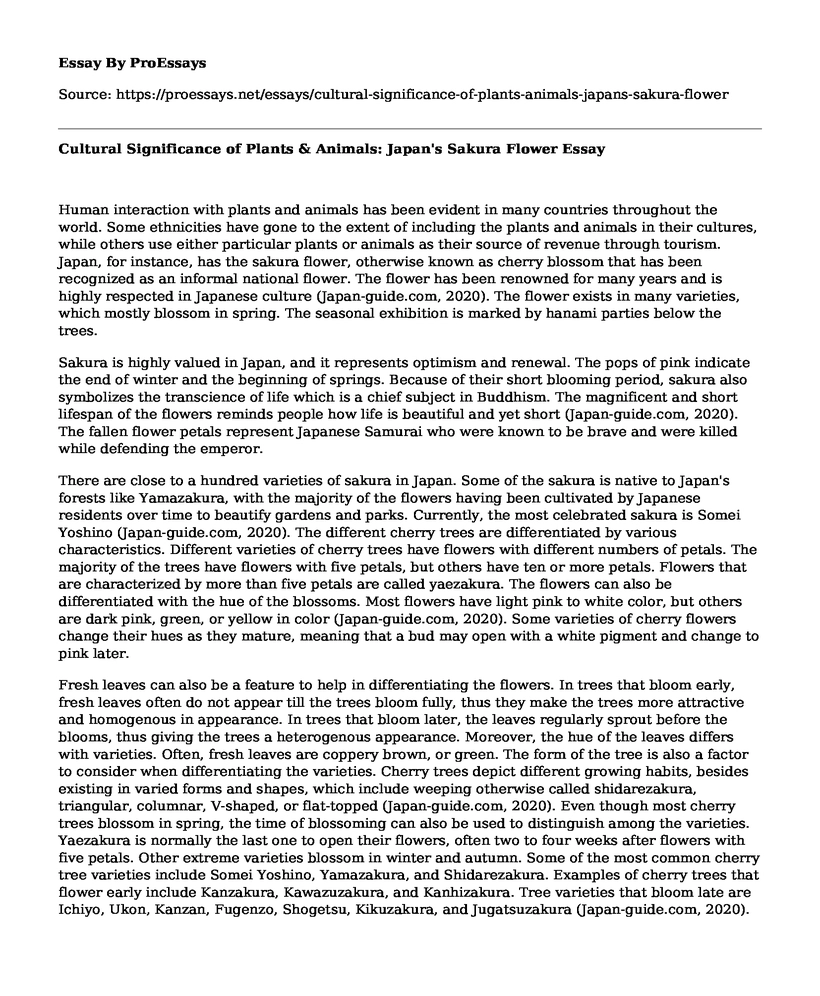Human interaction with plants and animals has been evident in many countries throughout the world. Some ethnicities have gone to the extent of including the plants and animals in their cultures, while others use either particular plants or animals as their source of revenue through tourism. Japan, for instance, has the sakura flower, otherwise known as cherry blossom that has been recognized as an informal national flower. The flower has been renowned for many years and is highly respected in Japanese culture (Japan-guide.com, 2020). The flower exists in many varieties, which mostly blossom in spring. The seasonal exhibition is marked by hanami parties below the trees.
Sakura is highly valued in Japan, and it represents optimism and renewal. The pops of pink indicate the end of winter and the beginning of springs. Because of their short blooming period, sakura also symbolizes the transcience of life which is a chief subject in Buddhism. The magnificent and short lifespan of the flowers reminds people how life is beautiful and yet short (Japan-guide.com, 2020). The fallen flower petals represent Japanese Samurai who were known to be brave and were killed while defending the emperor.
There are close to a hundred varieties of sakura in Japan. Some of the sakura is native to Japan's forests like Yamazakura, with the majority of the flowers having been cultivated by Japanese residents over time to beautify gardens and parks. Currently, the most celebrated sakura is Somei Yoshino (Japan-guide.com, 2020). The different cherry trees are differentiated by various characteristics. Different varieties of cherry trees have flowers with different numbers of petals. The majority of the trees have flowers with five petals, but others have ten or more petals. Flowers that are characterized by more than five petals are called yaezakura. The flowers can also be differentiated with the hue of the blossoms. Most flowers have light pink to white color, but others are dark pink, green, or yellow in color (Japan-guide.com, 2020). Some varieties of cherry flowers change their hues as they mature, meaning that a bud may open with a white pigment and change to pink later.
Fresh leaves can also be a feature to help in differentiating the flowers. In trees that bloom early, fresh leaves often do not appear till the trees bloom fully, thus they make the trees more attractive and homogenous in appearance. In trees that bloom later, the leaves regularly sprout before the blooms, thus giving the trees a heterogenous appearance. Moreover, the hue of the leaves differs with varieties. Often, fresh leaves are coppery brown, or green. The form of the tree is also a factor to consider when differentiating the varieties. Cherry trees depict different growing habits, besides existing in varied forms and shapes, which include weeping otherwise called shidarezakura, triangular, columnar, V-shaped, or flat-topped (Japan-guide.com, 2020). Even though most cherry trees blossom in spring, the time of blossoming can also be used to distinguish among the varieties. Yaezakura is normally the last one to open their flowers, often two to four weeks after flowers with five petals. Other extreme varieties blossom in winter and autumn. Some of the most common cherry tree varieties include Somei Yoshino, Yamazakura, and Shidarezakura. Examples of cherry trees that flower early include Kanzakura, Kawazuzakura, and Kanhizakura. Tree varieties that bloom late are Ichiyo, Ukon, Kanzan, Fugenzo, Shogetsu, Kikuzakura, and Jugatsuzakura (Japan-guide.com, 2020).
There are different hanami spots in Japan, with each spot having its own unique timing. Geographical location plays a big part in determining the time the flowers will bloom. Flowers open earlier in milder climates, with the blooming time in southern Japan being January, northern being May, while in the other cities flowers blossom in May. The blossoming time differs from one year to the other depending on the weather. Cold weather causes late blooming. The blooming season is always relatively short. Hanami is done in different ways, with some people preferring to concentrate on a single tree while others party under the trees. While viewing the blossoms, it is advised that a person handles the tree carefully while avoiding to shake it, pulling its branches, or picking the flowers.
References
Japan-guide.com. (2020). Cherry tree varieties. https://www.japan-guide.com/e/e2011_species.html
Cite this page
Cultural Significance of Plants & Animals: Japan's Sakura Flower. (2023, Jun 07). Retrieved from https://proessays.net/essays/cultural-significance-of-plants-animals-japans-sakura-flower
If you are the original author of this essay and no longer wish to have it published on the ProEssays website, please click below to request its removal:
- Sex, Gender and Sexual Orientation
- A Rationale for Why They Chose This Family
- Society Value in Gattaca Essay
- Essay Sample on Pre-Marital Sex: An Ethical Dilemma in Contemporary Society
- Effective System of Care for Youth & Children: Engaging for Success - Essay Sample
- Seniors' Sexuality: Breaking Through the Silence, Misconceptions, and Stigmas - Essay Sample
- Report on Venezuela's Political Crisis: Impact on Society, International Relations, and Humanitarian Challenges







